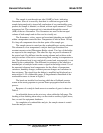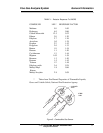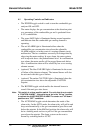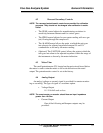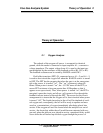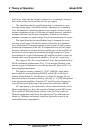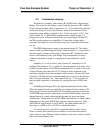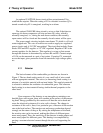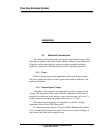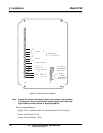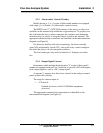
2-3
Flue Gas Analysis System Theory of Operation 2
TELEDYNE BROWN ENGINEERING
Analytical Instruments
2.2 Combustible Analyzer
The detector assembly and resistors R7 and R8 form a Wheatstone
Bridge. The signal for the bridge is taken from the junction of R7 and R8
for the reference signal which is applied to A1—A3, and from the junction
of the measuring (or active) and reference beads of the detector for the
measuring signal which is applied to A1—2 (See drawing C-11751. Inte-
grated circuit A1 is a differential amplifier whose output (at pin 1) is
proportion l to the difference between the two input signals. Diodes D7
and D8 provide protection to amplifier A1 from high voltage spikes,
transients that might be caused from the long lines connected to the detec-
tor, etc.
The ZERO adjustment is made at the potentiometer P1. The adjust-
ment is made by unbalancing the bridge. Potentiometer P1 is connected to
the same supply voltage as the bridge with resistor R9 connected to the
center of the reference side of the bridge. This arrangement provides
sufficient unbalance voltage to compensate for the unbalance of the
sensor.
Amplifier A1 is set up with a gain of about 20, nominally for 5%
methane. The output at A1-1 is about 2 volts nominal full scale. One volt is
picked off at the center of the SPAN potentiometer P2 in order to drive the
voltage follower (the other half of A1) which provides isolation of the
first-stage amplifier from the remainder of the circuitry. Resistor R32 and
Capacitor C18 filter out any noise that might have come in on the detector
lines, electrical transients, etc.. The output from A1—7 also provides an
analog signal output that is selectable by varying the values of R28 and
R29.
ALARM potentiometer P3 is the setpoint adjustment for the alarm.
When the output from the gas amplifier goes higher than the setting of P3,
transistor Q1 is turned on and relay K2 is energized, resulting in an alarm.
A BUZZER toggle switch, when placed in the ALARM setting, allows an
internal buzzer to sound, indicating that the unit has gone into alarm.
Additionally, illumination of a red ALARM light indicates an alarm (while
illumination of the green SAFE light indicates normal operation). If the
AUTO/MAN toggle switch is set to MAN, the alarm latches and it is
necessary to switch to Al, to AUTO to unlatch the alarm.
As noted previously, relay K2 is energized when an alarm occurs.
With no alarm, the normally closed contact is closed and the normally
open contact is open. When an alarm condition occurs, the contacts transfer
and reverse their normal state.




